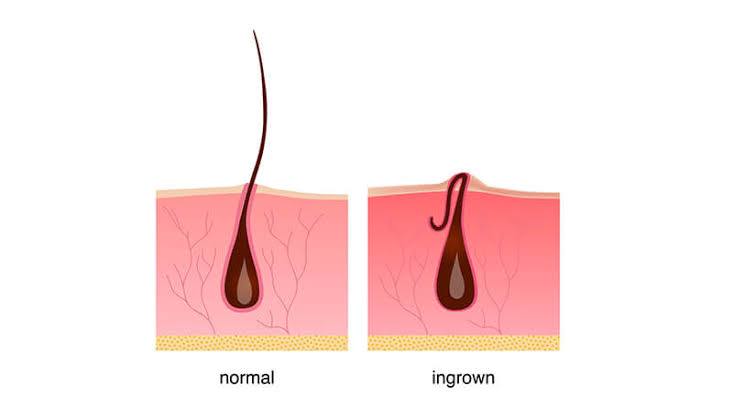
When shaved or tweezed hair grows back into the skin, it is called ingrown hair. Inflammation, discomfort, and little bumps in the area where the hair was removed are possible side effects.

Hair removal can cause ingrown hair, which is a typical problem. It’s more common in black men who shave their faces. Ingrown hair, on the other hand, can afflict anyone who shaves, tweezes, or waxes their hair.
Ingrown hairs frequently improve without therapy. By not removing hair, you can avoid ingrown hair. If that isn’t an option, hair removal procedures that reduce the risk of ingrown hairs can be used.
Symptoms
Ingrown hairs are most common in the beard area, particularly the chin and cheeks, as well as the neck. Those who shave their heads may notice them on the scalp. Ingrown hairs are also frequent in the armpits, pubic area, and legs.
The following are some of the signs and symptoms:
Bumps that are small, solid, and spherical (papules)
Lesions that are small, pus-filled, and blister-like (pustules)
Darkening of the skin (hyperpigmentation)
Pain\sItching
Embedded hairs
Causes
Ingrown hairs are caused by hair structure and growth direction. When hair is cut and starts to grow back, it is thought that a curved hair follicle, which generates tightly curled hair, encourages the hair to re-enter the skin. In this type of hair, shaving creates sharp edges, especially if the hair is dry when shaven.
Ingrown hairs can also occur if you:
Pull your skin taut while shaving — this causes the cut hair to draw back into the skin and re-enter the skin without needing to grow out Tweeze — this can also leave a hair fragment under the skin surface.
When a hair penetrates your skin, it reacts in the same way that a foreign body would: it becomes irritated.
Factors that are at risk
Ingrown hairs are most commonly caused by tightly curled hair.
Complications
Barbae Pseudofolliculitis
Ingrown hairs that are left untreated can cause:
Infection with bacteria (from scratching)
Darkening of the skin (hyperpigmentation)
Scarring that lasts a lifetime (keloids)
Razor bumps are caused by Pseudofolliculitis barbae.
Prevention
Avoid shaving, tweezing, and waxing to help prevent ingrown hairs. If that isn’t a possibility, use these steps to reduce the likelihood of ingrown hairs:
Before shaving, wash your face with warm water and a light facial cleanser.
To soften the hair, apply lubricating shaving cream or gel a few minutes before shaving. Alternatively, use a warm compress.
Every time you shave, use a sharp razor. In order to discover whether a single-blade or multiple-blade razor is preferable for preventing ingrown hair, more research is needed. Examine your options to see what works best for you.
Close shaves should be avoided.
When shaving, don’t pull your skin taut.
Shave in the same direction that your hair grows.
After each stroke, rinse the blade.
After shaving, rinse your skin and apply lotion.








